Core–shell potassium niobate nanowires for enhanced nonlinear optical effects†
Abstract
We demonstrate the synthesis as well as the optical characterization of core–shell nanowires. The wires consist of a potassium niobate (KNbO3) core and a gold shell. The nonlinear optical properties of the core are combined with the plasmonic resonance of the shell and offer an enhanced optical signal in the near infrared spectral range. We compare two different functionalization schemes of the core material prior to the shell growth process: silanization and polyelectrolyte. We show that the latter leads to a smoother and complete core–shell nanostructure and an easier-to-use synthesis process. A Mie-theory based theoretical approach is presented to model the enhanced second-harmonic generated (SHG) signal of the core–shell wires, illustrating the influence of the fabrication-induced varying geometrical factors of wire radius and shell thickness. A spectroscopic measurement on a core–shell nanowire shows a strong localized surface plasmon resonance close to 900 nm, which matches with the SHG resonance obtained from nonlinear optical experiments with the same nanowire. According to the simulation, this corresponds to a wire radius of 35 nm and a shell thickness of 7.5 nm. By comparing SHG signals measured from an uncoated nanowire and the coated one, we obtain a 250 times enhancement factor. This is less than the calculated enhancement, which considers a cylindrical nanowire with a perfectly smooth shell. Thus, we explain this discrepancy mainly with the roughness of the synthesized gold shell.


 Please wait while we load your content...
Please wait while we load your content...